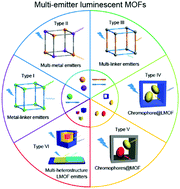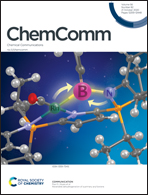Design and properties of multiple-emitter luminescent metal–organic frameworks
Abstract
Multi-emitter luminescent metal–organic frameworks (LMOFs) possess multiple emission bands that can cover a wider spectral region, which is a prerequisite for white-light emitting and multi-dimensional ratiometric fluorescent sensing. By taking advantage of the structure features of MOFs (e.g. hybrid structure, porosity) and the various luminescence origins of LMOFs, different emission sources can be designed and combined with each other into a homogeneous solid-state LMOF phase with the desired emission properties. This feature article reviews the recent development of multi-emitter LMOFs, and focuses on the design strategies for creating multi-emitter LMOFs based on at least two emission centers. The design strategies are classified into and discussed along six categories: type I metal-linker emitters, Type II multi-metal emitters, Type III multi-linker emitters, Type IV chromophore@LMOF (chromophore incorporated into an already luminescent MOF), Type V chromophores@MOF (multi-chromophores embedded into a non-emissive MOF) and Type VI multi-heterostructure LMOF emitters. The new class of Type VI includes core–shell structured LMOF⊃LMOF and nanostructured LMOF/LMOF thin films on a substrate. The good spatial separation between the different emitters in their own but chemically linked LMOF phase can retain their emission properties with less interference with the other emitters.

- This article is part of the themed collection: Functional Coordination Networks


 Please wait while we load your content...
Please wait while we load your content...